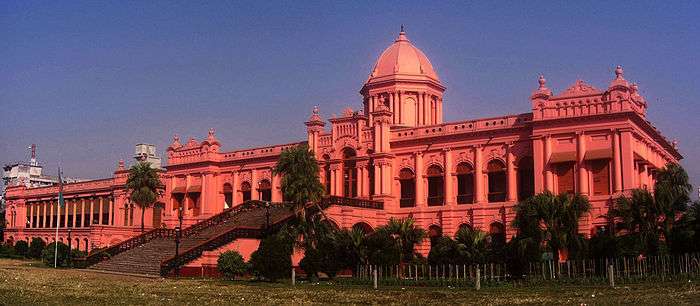Chakma Circle
| Part of a series on |
| Zamindars of Bengal |
|---|
 |
| Barisal and Khulna |
|
| Chittagong |
| Dhaka and Sylhet |
|
| Rajshahi and Rangpur |
|
| West Bengal |
The Chakma Circle (Burmese: သက်ထောင်), also known as the Chakma Raj, is one of three hereditary chiefdoms (or "circles") in the Chittagong Hill Tracts of modern-day Bangladesh.[1] The Chakma Circle encompasses parts of Rangamati Hill District and Dighinala and Rajasthali Upazilas in neighbouring Khagrachari District and Bandarban District respectively. The chiefdom's members are of Chakma descent.
Leadership
The Chakma Circle is led by a hereditary chieftain called a "raja," whose role encompasses judicial, administrative, ceremonial, legal and social responsibilities. Political power is passed from the father to the first-born son.[2]
The incumbent chieftain is Devasish Roy (b. 10 April 1959), according to the Chakma Bijok, a compilation of the Chakma history (1876-1934 CE). The Chakma chieftain also sits on the Advisory Council for the Ministry of Chittagong Hill Tracts Affairs and the Bandarban Hill District Council.[3] The Chakma chieftain leads a "rajpunnah" festival.[4]
History
Pre-colonial era
The lineage of Chakma chieftains may date to the 11th century or mid-16th century.[5][6] Chakma folklore and tradition ascribe the Chakma origins to the warrior castes of Bhagalpur in modern-day India.[7] The legendary raja Bijoy Giri (c. 1630), who is believed to have migrated the ancestors of the Chakma people north of the Naf River.[8] Through intermarriages with the Rakhine people, the Chakmas eventually converted to Buddhism.[8] Extant historical records date to the 1700s. Following the expansion of the Mughal Empire into Chakma territory, Chakma chieftains adopted Muslim names and titles (e.g., Khan) in exchange for tributary payments.[9][7]
British rule and modern era
During British rule, the Chittagong Hill Tracts were administratively divided into three circles in 1884, namely the Chakma Circle, the Bohmong Circle, and the Mong Circles, each presided over by a hereditary chief from the Chakma and Marma peoples.[8][10] The circles were codified into law with the Chittagong Hill Tracts Regulations, 1900, which eased revenue collection and administrative burdens on British authorities by delegating tax collection, land administration management and social arbitration responsibilities to the chieftains.[11][10] In 1901, the Bohmong Circle extended 2,421 square miles (6,270 km2).[12] This administrative structure remained in place until 1964, when the introduction of local self-government abolished the special status of these circles and brought local administration under the control of the central government.[13]
References
- ↑ Deakin, Liz; Kshatriya, Mrigesh; Sunderland, Terry (2016-01-25). Agrarian change in tropical landscapes. CIFOR. p. 194. ISBN 9786023870226.
- ↑ Ahmed, Kawser (2010). "Defining 'Indigenous' in Bangladesh: International Law in Domestic Context". International Journal on Minority and Group Rights. 17 (1): 47–73. JSTOR 24675834.
- ↑ "Chittagong Hill Tracts Peace Accord" (PDF). 1997-12-02.
- ↑ "Rajpunnah in Bandarban today". The Daily Star. 2009-02-04. Retrieved 2018-09-19.
- ↑ Dowlah, Caf (October 2013). "Jumma insurgency in Chittagong Hills Tracts: how serious is the threat to Bangladesh's national integration and what can be done?". Small Wars & Insurgencies. 24 (5): 773–794. doi:10.1080/09592318.2013.866419. ISSN 0959-2318.
- ↑ Soszynski, Henry. "CHAKMA". World of Royalty. Retrieved 2018-09-19.
- 1 2 Serajuddin, A. M.; Buller, John (1984). "The Chakma Tribe of the Chittagong Hill Tracts in the 18th Century". Journal of the Royal Asiatic Society of Great Britain and Ireland (1): 90–98. JSTOR 25211628.
- 1 2 3 Hutchinson, Robert Henry Sneyd (1906). An Account of the Chittagong Hill Tracts. Bengal Secretariat Book Depot. p. xvii.
- ↑ Jhala, Angma D. (January 2013). "Daughters of the Hills: legacies of colonialism, nationalism and religious communalism in the Chakma Raj family, Chittagong Hill Tracts, Bengal c. 1900–1972". South Asian History and Culture. 4 (1): 107–125. doi:10.1080/19472498.2012.750460. ISSN 1947-2498.
- 1 2 Kundu, Debasish; Samadder, Mrinmoy; Khan, Ashrafuzzaman; Shajahan Naomi, Sharin (2011-01-04). "State of Justice in Chittagong Hill Tracts: Exploring the Formal and Informal Justice Institutions of Indigenous Communities".
- ↑ "Bandarban wears festive look as Rajpunyah starts". The Daily Star. 2010-01-15. Retrieved 2018-09-19.
- ↑ Hutchinson, Robert Henry Sneyd (1906). An Account of the Chittagong Hill Tracts. Bengal Secretariat Book Depot. p. 122.
- ↑ Zaman, M. Q. (1982). "Crisis in Chittagong Hill Tracts: Ethnicity and Integration". Economic and Political Weekly. 17 (3): 75–80. JSTOR 4370578.